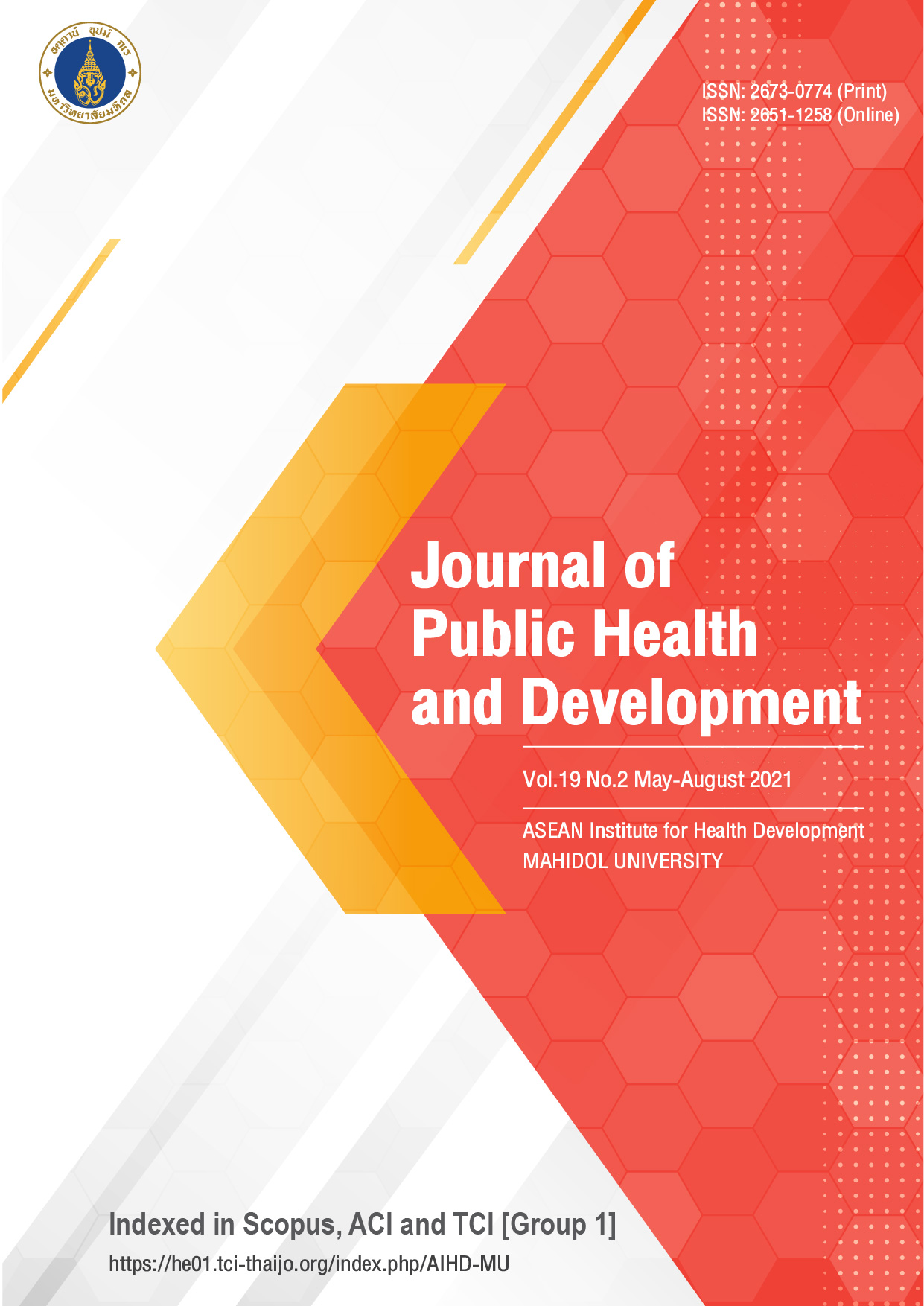Civil societies as the providers in area-based health promotion services under the universal health coverage, Thailand
Main Article Content
Abstract
Thailand’s National Health Security Act promoted a participatory process of civil society organizations (CSOs) by granting funds to provide health promotion and disease prevention (P&P) services in the community. This qualitative research aimed to elaborate CSOs’ participating roles and obstacles in providing P&P services and gave recommendations to improve the CSOs’ roles. The research methods included documentary research, in-depth interview, and focus group discussions. The study revealed that in 2020, twenty-one CSOs received a budget for a total value of 9.1 million baht, which was 3.8% of the total area-based fund. Moreover, 1,724 million baht, or 36.18% of the total community-based fund, was granted to CSOs under 75,698 community-based projects. As a result, people gained more access to the services, especially those whose regular service providers were unable to provide. However, it was found that the area-based budget was allocated for CSOs in a very small proportion. This was due to the issues in attitudes and mistrust in CSOs’ capabilities and the lack of clear criteria for budget approval. Therefore, it was a challenge to earnestly promote the participation of civil society in P&P activities in all the areas of Thailand.
Article Details

This work is licensed under a Creative Commons Attribution-NonCommercial-NoDerivatives 4.0 International License.
References
The Guardian. What Thailand can teach the world about universal healthcare [Internet]. [Cited 2020 May 25]. Available from: https://www. theguardian.com/health-revolution/ 2016/may/24/thailand-universal-healthcare-ucs-patients-government-political
Tangcharoensathien V, Suphanchaimat R, Thammatacharee N, Patchara-narumol W. Thailand’s Universal Health Coverage Scheme. Econ Polit Wkly. 2012; 47(8):53-57.
The United Nations. UN HIGH-LEVEL MEETING ON UHC [Internet]. [Cited 2020 May 25]. Available from: http://universalhealth coverageday.org/un-high-level-meeting-on-uhc/
Tangcharoensathien V, Limwattananon S, Patcharanarumol W, Thammata-charee J, Jongudomsuk P, Sirilak S. Achieving universal health coverage goals in Thailand: the vital role of strategic purchasing. Health Policy Plan. 2015; 30:1152–1161.
IOL Social Protection Department. Thailand: Universal Health-care Coverage Scheme [Internet]. [Cited 2021 February 3]. Available from: https://www.social-protection.org/ RessourcePDF.action
The United Nations. The Civil Society Unit. Who are we [Internet]. [Cited 2021 February 2]. Available from: https://www.un.org/en/civil-society/ page/about-us
Alfers L, Lund F. Four Lessons from Thailand’s Participatory Process in Gaining Universal Health Coverage [Internet]. [Cited 2021 February 3]. Available from: https://www.wiego. org/blog/four-lessons-thailand% E2%80%99s-participatory-process-gaining-universal-health-coverage
National Health Security Office. National Health Security Act 2002. Thai government gazette No.119 Section 116A (November 18, 2002). (in Thai).
McManus J. Thailand’s Universal Coverage Scheme: Achievements and Challenges. An independent assess-ment of the first 10 years (2001-2010). Nonthaburi: Health Insurance System Research Office; 2012.
Tangcharoensathien V, Witthayapipop-sakul W, Panichkriangkrai W, Patcharanarumol W, Mills A. Health systems development in Thailand: a solid platform for the successful implementation of universal health coverage. Lancet. 2018; 391: 1205–1223.
Watabe A, Wongwatanakul W, Thamarangsi T, Prakongsai P, Yuasa M. Analysis of health promotion and prevention financing mechanisms in Thailand. Health Promot Int. 2017; 32(4): 702–710. doi: 10.1093/heapro/ daw010.
National Health Security Office. National Health Security Office Database: Health promotion and disease prevention service performance information 2019.
Aljunid SM, Srithamrongsawat S, Chen W, Jin Bae S, Pwe RF. Health-Care Data Collecting, Sharing, and Using in Thailand, China Mainland, South Korea, Taiwan, Japan, and Malaysia. Value Health. 2012; 15(1 Suppl): s132-s138.
National Health Security Office. National Health Security Board’s Resolution. Number 7:2553 (July 12, 2010). (in Thai)
National Health Security Office. Manual for National Health Security Fund Management, 2019. Nonthaburi: Sahamitr Printing and Publishing Company Limited 2019. (in Thai).
National Council for Peace and Order, Number 37:2559. The necessary expenditure for support and promote health service providing and other expenditures under the National Health Security System. Thai government gazette. Number 133 Special Section 150 d, p30 (July 5, 2016). (in Thai)
Archananuparp S. Health Promotion: Concepts, principles, and lessons learned in Thailand. Bangkok: Moh-Chao-Ban Publishing House 2007. (in Thai).
Aunpromee S. The critical development of Health Promotion. Nonthaburi: Academic Welfare Project, Praboro-marajchanok Institute, Ministry of Public Health 2013. (in Thai).
Eurasian Harm Reduction Network. CONTRACTING PUBLIC HEALTH-CARE AND SOCIAL SERVICES TO CSOs: framework, opportunities, lessons learned [Internet]. [Cited 2020 December 3]. Available from: https:// harmreductioneurasia.org/wp-content/ uploads/2019/03/Bulgaria-NGO-funding-mechanisms-analysis.pdf
The World Bank. ENGAGING WITH CIVIL SOCIETY IN THE HEALTH SECTOR IN INDONESIA [Internet]. [Cited 2020 December 5]. Available from:http://documents1.worldbank.org/curated/en/637901568357782768/ pdf/Engaging-with-Civil-Society-in-the-Health-Sector-in-Indonesia.pdf
Sirisinsuk Y. Lesson learned from people participation in managing Regional Health Preventive and Promotion Budget. Bangkok: National Health Security Office 2019. (in Thai).
Seddoh JE. Stakeholder perception on factors influencing NGO collaboration with the government in family health education in the Tema Metropolis of the Greater Accra Region of Ghana. Global Journal of Political Science and Administration 2016; 4(3):20-33.
Brunner-Ziegler S, Rieder A, Stein KV, Koppensteiner R, Hoffmann K, Dorner TE. Predictors of participation in preventive health examinations in Austria. BMC Public Health. 2013; 13: 1138. doi:org/10.1186/1471-2458-13-1138.
Chien SY, Chuang MC, Chen IP, Yu PH. Primary drivers of willingness to continue to participate in community-based health screening for chronic diseases. Int. J. Environ. Res. Public Health. 2019;16:1645. doi: 10.3390/ ijerph16091645
World Health Organization. 2008. Community involvement in tuber-culosis care and prevention towards partnerships for health [Internet]. [Cited 2020 December 13]. Available from: https://apps.who.int/iris/bitstream/ handle/10665/43842/9789241596404_eng.pdf;jsessionid=881351E1F6879ACECA8FA3DB5633796A?sequence=1
Sharma N, Harris E, Lloyd J, Mistry SK, Harris M. Community health workers involvement in preventative care in primary healthcare: a systematic scoping review. BMJ Open. 2019;9: e031666. doi: 10.1136/bmjopen-2019-031666
Hankin JR. FAS Prevention Strategies: Passive and Active Measures. Alcohol health and research world 1994;18(1): 62–66.


